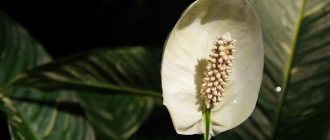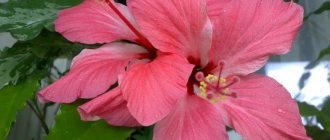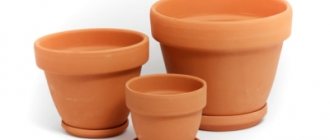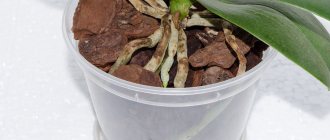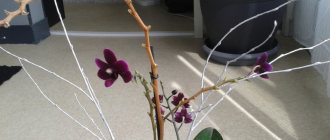Why do this?
Indoor hibiscus requires pruning for a number of reasons:
- To remove shoots that have acquired an unaesthetic shape, bent and shortened under the influence of time.
- To give the hibiscus shape. After the procedure, he actively grows new shoots.
- For rejuvenation. To get rid of old dried twigs.
- To remove diseased shoots. This is the so-called sanitary pruning, when the affected parts are cut off with a slight inclusion of healthy parts.
- So that the hibiscus actively develops and blooms profusely.
If hibiscus is not pruned at home, the formation of side branches, buds and flowers will stop. Hibiscus flowers can only appear on young shoots.
Pruning a home flower
How can you prune a house flower? Depending on the age of the plant, its condition and the expected shape of the crown, there are 5 types of pruning:
- Pinching is suitable for young plants.
- This is the most gentle type of pruning.
- Used to stimulate growth.
- It consists of removing the tops of all branches above the top node.
- You need to pinch when the plant is about 13 - 15 cm high.
- To strengthen the trunk when pinching, the central shoot is attached to a base (for example, to a bamboo skewer).
- Selective pruning is done not only to stimulate growth, but also to maintain the shape of the plant. This type of pruning is a more thorough shortening of branches: several already well-developed internodes are cut off. Certain areas that disrupt the shape of the crown are trimmed.
The sequence of this type of hibiscus pruning is as follows:- Trim the side shoots, leaving up to 4 - 5 leaves.
Make the cut just above the node, leaving at least 2/3 of the branch.
- Branches growing parallel to the central trunk and inside the crown also need to be pruned.
- Pruning should be done above the growing point, which faces outward.
Reference: the cut is made at an angle of 45 degrees. - Full pruning ensures abundant flowering of the plant. Produced in early spring to obtain abundant flowering. When fully pruned, each branch is shortened to two to three buds.
- Sanitary pruning involves removing disease-damaged areas of the plant. The cut is made until living wood appears. If the cut is green, then the branch is alive. A brown and white branch cut requires immediate pruning.
When pruning, do not try to leave as many shoots as possible. Don't be afraid to trim! Even if you cut off the excess, the plant will survive everything. Pruning tools must be sharp and disinfected.
How to form a crown at home?
Formative pruning is the most difficult type of hibiscus pruning.
Purpose of the procedure and the best time for it
The Chinese rose is formed in order to obtain the desired shape of the crown and the entire plant. The more often the crown can be shaped by pruning, the better the plant will develop and achieve the correct shape.
They begin to form a crown in the spring, after the plant’s dormant period ends. The shape of the hibiscus is maintained through selective pruning.
How to trim a bush correctly in spring?
The rules for pruning hibiscus depend on what type of crown is expected to be obtained after the procedure. It can be a lush tree, a branched shrub, or a miniature bush.
- To form a Chinese rose in the form of a tree, you should:
- Remove side branches.
- Leave a couple of medium branches, shortening them by only 2 - 3 buds. In the future this will be the main trunk.
- To form a hibiscus in the form of a lush bush you need:
- Trim the middle-most upper branches. At the same time, the lateral buds will begin to form new shoots.
- Shorten the central branch, leaving only a few growing points.
- To form a lush crown:
- Remove all useless branches: internal, parallel to the main trunk, gnarled, deformed and growing inward.
- Clear the crown of faded flowers in a timely manner. This promotes the development and blooming of new buds.
When is the best time to prune?
The optimal pruning periods are spring and autumn. In the fall, you can do this after flowering stops. In spring, it is very important not to miss the moment and carry out the procedure before the flower buds open. If you prune at the wrong time and expose young shoots to this, flowering may not occur. New buds form only on young shoots. The time of active growth and flowering (from April to September) is absolutely not acceptable for pruning.
The beginning of winter (December) is the transition of the plant to the dormant stage; pruning at this time can provoke the formation of shoots, which is undesirable, as it will weaken the plant preparing for a new flowering. Pruning during the flowering period is also undesirable. This is an extreme measure, the need for which can be justified to save the plant from any pests.
How to form a crown correctly?
There are two ways to form a hibiscus crown: a lush crown and a horizontal one.
A lush crown must be formed more carefully and more often than a horizontal one. Here is what someone likes best, what suits the interior best, and so on.
One of the advantages of hibiscus is that it allows you to have both a lush crown and a tall tree.
Trim with ordinary scissors - the flower branches are too thin for pruning shears.
It is necessary to cut off shoots growing parallel to the main branches. All dry branches must also be removed.
In order for the plant to become lush, it must be pruned as follows: take an area about 1/3 above the leaf facing outward and cut it off.
Hibiscus should be pruned every year in the spring. In autumn, after each flowering, the plant also needs pruning. If this is not done, the side shoots will not grow and there will be no new buds or flowers. Moreover, hibiscus flowers appear only on young shoots.
Therefore, in order for it to bloom, you need to prune it as often as possible. In addition, the crown of the plant will become thicker and more spreading.
It is not recommended to prune in summer - this way you will not get flowers.
What to do if the plant begins to wither?
Wilting of hibiscus after pruning is quite rare. The flower is absolutely calm about pruning. And if this happens, the reason lies in a violation of the adaptation regime of the pruned hibiscus or the rules of general care. Let us note the main ones:
Insufficient watering. Beginning gardeners understand by limiting watering during the adaptation period to almost completely stop it. The frequency and abundance of watering depend on the temperature and humidity of the room. An excessive increase in room temperature should be a reason to increase watering. A significant decrease in humidity requires additional spraying. Using very hot or cold water for irrigation
It should be noted that water should not be left standing under the scorching rays of the sun.
When caring for hibiscus, it is important to replant the plant correctly and on time, which you can learn about in our separate article.
So, the problem of the plant withering after pruning is solved by normalizing the conditions for caring for it. Thus, with proper care, the Chinese rose needs systematic pruning. And the more old and deformed branches are cut off, the more nutrition the young shoots will receive. Only competent formation of the hibiscus crown will make this flower unique in its beauty.
Features of holding at different times of the year
in spring
The flower of the Chinese Rose is formed at the very top of the shoot (young), it turns out that the more our plant begins to bush, the more magnificent it will bloom.
Therefore, there is no need to be afraid to remove excess; after pruning, the bush will produce many new shoots and branches, at the ends of which buds will form. However, there are still some restrictions - it is undesirable to trim more than 2/3 of the total volume of the plant. It is important to decide on the desired shape of the bush before starting the procedure, and not during the process, in order to avoid mistakes. The pruning location should be above the outward-facing bud, and the cut should be made at a 45-degree angle.
In the spring, the bush is usually completely pruned, that is, all branches are shortened by 2/3. It is imperative to remove all the “tops” growing parallel to the main stem and branches that grow inside the crown.
IMPORTANT! Pruning tools must be very sharp and clean! The cut area should be smooth, not torn.
in autumn
Carried out after flowering has completely completed, you need to shorten all the branches that were blooming. Usually, formative pruning is carried out in the fall, that is, by 1/3 of the length of the branches. If you are growing a small plant and do not want it to grow, then you will have to shorten the entire crown - all the branches.
All broken and diseased branches (if any) are removed; it is also necessary to remove the tops if they appear again. There is another option - in the fall you can cut the plant down to the stump (leave about 5 cm) and put it in a cool place in the shade, and in the spring it will begin to grow vigorously.
When to prune indoor hibiscus and how to do it
If we are talking about indoor hibiscus, in most cases it will be a Chinese rose. It looks great, very different from other plants. It seems as if a small tree with a lush crown is growing in the room.
Let's consider the question: when to prune indoor hibiscus? If the hibiscus is not pruned, it will grow upward without forming a lush crown, and flowering will be rare, because flowers form only on the top of each branch, and buds appear only on new shoots. With proper pruning you will get a lot of branches and flowers. If it is wrong, everything will not be so positive.
The plant is pruned not only for this reason. Trimming and pinching are carried out for the following:
• getting rid of irregularly shaped shoots; • freeing from diseased shoots, it is also called sanitary pruning; • for the purpose of rejuvenation, they get rid of dried branches; • to give the hibiscus a lush shape; • in some cases, root pruning is practiced, but this is a very delicate procedure; if you prune incorrectly, you can destroy the plant; in many cases it is good if the roots are a little cramped in the pot.
However, every rule has its exceptions. For example, when it comes to the shape of the hibiscus crown, whether it is lush or not is not an indicator of correctness, here to each his own. Some people like it growing tall, others like voluminous hair, sometimes it’s a practical question - how it will look in the interior.
Unlike some other plants, indoor hibiscus is difficult to trim with garden pruners; regular, but well-sharpened scissors are well suited for this purpose.
It is correct to prune in autumn and spring. This procedure is carried out in the spring so that the plant grows actively and properly, in the fall - for a good wintering. If you do not prune, there will be no flowering, because flowers appear only on new shoots.
When pruning, remove:
• diseased shoots - so that the disease does not spread further; • crooked shoots – for aesthetic appearance; • remove dry branches - they are not needed; • shoots are also cut off if they grow parallel to the main ones - this is good for the aesthetic appearance, and the leading shoots will get more resources.
In summer, pruning is not carried out.
In addition to pruning, pinching is practiced. Young growth is pinched in early spring. How to do it correctly:
1. Tie the central shoot to something, for example, a bamboo stick, pencil or the like. 2. Trim the side shoots, taking into account the need to leave about four (or three, four, five) leaves. 3. Pinch off the tops of the flowers, leaving up to six healthy shoots.
Important! Prune in the spring before flowering begins, and in the fall after flowering ends. In summer and winter, pruning and pinching are not carried out
What types of plant pruning can be divided into?
1. Pinching. 2. Selective. 3. Corrective. 4. Strong.
Proper pruning
Garden pruning shears may not be suitable because the stems are too thin, so regular scissors will do, but they must be well sharpened so as not to damage the stem. Shoots and branches are cut precisely at an angle of 45 degrees. When cutting a branch, leave at least 2 cm above the bud.
The cut site should be treated to prevent moisture from entering the trunk; activated carbon or charcoal ground to a powder form is suitable for treatment. If you do not need to do a full trim, leave a third of the length.
When new shoots appear, examine them; weak ones can be safely removed. If you want to give your indoor hibiscus a certain shape, you need to provide the plant with tensioners and supports that will lead the growth in the desired direction, and you will also need appropriate pruning. If you want to get a lush crown, trim the branches without branches, after pruning they will appear.
Trim off the top of the branches, if there are no buds on them, they grow only on young shoots. Preventative pruning is carried out in the fall, but if your goal is to grow hibiscus to its maximum height, autumn pruning is not carried out.
If the plant needs to be transplanted into new soil, the shoots and branches are cut off after transplantation (replacing the old soil with new one). When you cut off a woody but viable branch, you can make cuttings to use for new seedlings at home or to give as a gift to someone.
Heavy pruning is rarely done. It is needed in cases where the plant is significantly affected and does not respond to other rescue measures. Only a few healthy buds are left at the root base - everything else is cut off. If the root system is healthy, the hibiscus should germinate again.
Beginning flower growers often make mistakes typical for beginners. Consultation with experienced colleagues and specialists in the field of growing house plants will help you avoid them.
Pruning old and new plants - is there a difference?
Of course, there is a difference between pruning an old mature plant and a new young one, let's figure it out /p>
- Pruning a new plant - a young new bush requires gentle pruning, which is called pinching. After all, for such a plant there is no need yet to carry out serious pruning to stimulate the growth of new young shoots. In a young bush, you need to pinch the very tips of all the branches above the top bud and this will be enough.
- Pruning an old plant - it requires more drastic pruning - or shortening all shoots by 2/3, or in some cases, the Chinese Rose is almost completely cut off, leaving a small stump (in the fall). So from such a stump, one might say, from the roots, a new strong plant grows - the Chinese Rose has such a unique ability. Thanks to pruning, the old bush undergoes a rejuvenation procedure, a powerful impetus is given for the growth of young shoots and the quality of flowering increases.
How to prune a plant correctly?
The procedure depends on the goals of the procedure.
Formation of the crown of indoor hibiscus
The crown of hibiscus can come in a wide variety of shapes.
The option is selected depending on the interior of the room and the aesthetic preferences of the plant owner. Some time after pruning, new shoots begin to appear on the Chinese rose, which will create a beautiful crown.
- Non-viable dry shoots and branches growing parallel to others are pruned.
- Weak, deformed, damaged shoots must also be removed.
Maintenance haircut
Performed after the desired crown type has been achieved.
- Weak and dried shoots are cut out.
- All thin branches are cut to the level of 2-3 buds.
- If the Chinese rose has acquired a one-sided appearance, all unwanted shoots are removed to the very base of the bush.
Formation of a trunk
It is carried out after planting a Chinese rose.
- All branched shoots are removed to the level of 2-3 buds.
- The main developed trunk does not need to be trimmed.
- In February, all side shoots are removed to the level of 1 bud, and the main trunk is pruned to the level of 5-6 buds.
- Pruning is carried out until the plant of the desired height is obtained.
- A crown is formed from the strongest young branches; further pruning is carried out into several buds.
- Lateral growth must be constantly removed.
Removing branches for sanitary purposes
- Time: early spring.
- All branches that have grown over the previous year are cut off by a third.
Rejuvenating haircut
- All old and dead parts are removed.
- The remaining shoots are cut by two thirds.
- Pruning should affect not only the external branches, but also those located inside the bush.
Important! For all types of Chinese rose pruning, only scissors or a sharp blade are used. The branches of the plant are too thin; pruning shears can damage them. The cuts are made at an angle of forty-five degrees and after the procedure is completed, they are sprinkled with charcoal.
Rules for pruning hibiscus
There are several requirements for pruning hibiscus. Basically, the rules vary depending on the purpose of pruning.
Crown formation
The crown of hibiscus can be lush or horizontal. A lush crown requires more careful care and frequent pruning. The type of crown is chosen by the plant owner depending on the interior and other parameters.
The main feature of hibiscus is that the height of the plant does not at all affect the splendor of the crown.
It is advisable to prune with ordinary scissors. The branches of the plant are quite thin; pruning shears can seriously damage them. All dry shoots are removed, as well as branches growing parallel to other branches.
Pruning is done in the spring, as well as in the fall after flowering. Untimely removal of branches can cause growth to stop; new buds and inflorescences will cease to form; hibiscus flowers may appear only on young shoots.
Never prune to form a crown in the summer, otherwise there will simply be no flowering.
Pinching young shoots
You can pinch all the young shoots of the hibiscus; the procedure will only benefit the plant itself. It is advisable to carry out activities in early spring before leaves form.
Pinching rules:
- The central shoot of the plant is tied to a support (a bamboo stick can be used as a support, however, an ordinary pencil or knitting needle will do);
- All side shoots are cut off, leaving about 5 leaves;
- It is necessary to periodically actively feed the plant with nitrogen;
- After the hibiscus has grown to the required length, the procedure of pinching the crown is carried out again - leaving 5-6 of the most developed shoots;
- Be sure to trim branches parallel to the main shoots, this way you will be able to achieve a uniform and lush crown;
- Pruning is done after and before each flowering; it is advisable to use ordinary scissors.
Shaping haircut
Immediately after planting, all weak, deformed and damaged shoots must be removed from the plant. Pruning helps ensure uniform development of the young bush. If you make drastic pruning during the growth of the plant, the crown will become more luxuriant.
Be patient - it can take more than one year to grow a beautiful flowering plant with the right type of crown.
Maintenance pruning
It is carried out after it has been possible to achieve the crown of the desired type. Maintenance pruning involves removing weak and dry shoots. All thin branches are cut to the level of 2-3 buds.
Sometimes over time the plant takes on a one-sided appearance. The problem is eliminated by removing all unwanted side shoots down to the base of the bush.
Formation of a trunk
After planting hibiscus, be sure to remove all branched shoots to the level of 2-3 buds. The main developed trunk is not cut off. With further growth of the plant in February, all branched side shoots are removed to the level of 1 bud, the main trunk is pruned to the level of 5-6 buds. Pruning is carried out until the plant reaches the desired height.
The crown is formed from the strongest shoots; further pruning is carried out into several buds. The lateral growth is constantly removed.
Hygienic pruning
Held in early spring. All growth over the past year is cut by a third. Hygienic pruning allows you to rid the plant of old and deformed shoots and increase the number of flower buds.
Hibiscus quickly acquires a lush crown, the branches interfere with the normal development of flowers, and therefore it is necessary to periodically perform light thinning.
To stimulate flowering in the spring, annual shoots are also radically pruned.
Rejuvenating haircut
If the bush begins to grow unevenly and skews on one side, rejuvenating cutting of the shoots is carried out. The rejuvenation procedure allows the plant to breathe more freely and stimulates it to produce fresh greenery.
The rejuvenation procedure is carried out as follows:
- All old and dead shoots are removed;
- The remaining shoots are shortened by two thirds.
Pruning should affect not only the external shoots, but also those located inside the bush.
To give the plant a beautiful and attractive shape, the branches should be trimmed to different lengths: the central shoot should be longer than the others, the side shoots should be cut at different heights.
Careful care and timely pruning of hibiscus will result in a plant with an attractive crown and abundant flowering.
Let's take a visual look at pruning indoor hibiscus in the video
Features of crown formation
How to prune hibiscus correctly to give the correct shape? There are two ways to form a crown: in the first case, we get a spreading crown, in the second, a horizontal one. The formation of hibiscus allows you to have a lush crown and a flowering slender tree. How to make a shaping haircut? You can choose the shape based on personal preferences or in accordance with the design of the room.
The procedure is carried out with ordinary scissors, since the hibiscus branches are thin. When forming the crown, shoots growing parallel to the branches are cut off. When the central branch is cut off, then the lateral shoots develop into full-fledged stems. Only the buds located at the bottom can be left, and the central part is removed. If you want to make the crown lush, then select an area located one third above the leaf that faces outward and cut it off.
Dry branches need to be disposed of regularly.
In order for new buds to form and the number of young shoots to increase, when shoots appear, starting from the third generation, several buds are cut off, shortening the branches. Pruning is carried out both in spring and in autumn after abundant flowering. The plant tolerates all types of pruning well, so you can bring all your ideas to life.
How to prune hibiscus? The standard is popular. This appearance makes the hibiscus even more spectacular. Forming a standard at home with your own hands is not an easy task. But if you follow all the instructions and carry out competent care at home, then getting an exquisite standard tree with a straight trunk and a spherical crown is quite possible. Some professionals can create hibiscus bonsai - cute miniature trees.
Careful care at home is necessary to maintain aesthetic shape. As we said earlier, a haircut can be done at least once a year. To do this, the branches of the young plant are tied to tension devices. Their growth is directed with great care using wire.
When the branches grow a couple of tens of centimeters, they need to be cut off, leaving more than three leaves.
When a bonsai tree is formed, flowering may stop. Don't be upset, the flowers will appear later. In mature miniature bonsai-style trees, the shoots are shortened after flowering has ended.
Rules for successful pruning
- First you need to decide for what purpose the pruning is carried out and in what way it will be carried out. The formation of flowers in Chinese roses occurs at the tops of the stems. When the branches are pruned, the tree begins to bush more and produces more flowers. The plant is pruned in early spring; hibiscus can be trimmed a little in the fall.
- Pruning tools must be clean and very sharp. Poorly sharpened scissors and knives make the cut torn, worsen the appearance of the plant, and cut branches will take a long time to heal. Before each pruning procedure, tools are not only washed, but also disinfected. It is best to use alcohol for disinfection.
- It is best to prune hibiscus after transplantation, in spring or summer. After the procedures, caring for the rose remains the same.
- Even before you start pruning, you need to decide what shape you need. All cuts must be made at an angle of 45 degrees. Caring for a rose immediately after pruning, in order to avoid infection of the Chinese rose and for faster healing of wounds, includes sprinkling all cuts with crushed charcoal. You can use charcoal or activated carbon.
- The top of the plant is trimmed, moving away from the place where the last upper branches grow. The shoots are shortened a second time when the plant finishes flowering.
- The main rule for pruning a Chinese rose is that you can trim no more than 2/3 of all branches.
Thanks to these rules, the plant will receive minimal injuries, which will heal quickly.
How to prune hibiscus
The most popular form of hibiscus, which has a very impressive appearance, is the standard.
Forming it at home is not so easy, and after the plant takes on the desired shape, regular care is required for the branches to maintain the standard shape of the crown. But if you follow the instructions, you can get an amazing standard Chinese rose tree.
- To obtain a standard form, choose a young hibiscus. Its central shoot must be straight. Then this shoot is tied to a reliable support at the same distance and is not removed until the trunk becomes strong and stable. Growing side shoots are periodically removed.
- When the plant reaches the required height, the top of the plant is pinched. This is done to stimulate the growth of side shoots.
- After removing the top, the hibiscus will begin to actively branch. Therefore, the side branches are shortened and pinched monthly. This measure will promote the growth of dormant buds and the growth of new shoots.
- All lower shoots continue to be removed, but the upper ones are not touched. Over time, the plant will acquire the desired spherical shape.
To maintain a neat decorative shape at home, careful care is required. Hibiscus is periodically trimmed, preventing the crown from growing. The haircut is done once a year in the autumn months. If you do this at another time, the hibiscus will not bloom.
You can try growing a bonsai-style tree from hibiscus. But the formation of a Chinese rose for such a plant is very difficult and time-consuming. Professional florists can produce beautiful trees decorated with many flowers.
Such plants will look very impressive and unusual in the interior. The main problem when forming a bonsai is that the hibiscus branches quickly become thick and woody.
To form a bonsai, you need to take a young plant. Its branches are tied to supports and tension devices
You need to guide their growth very carefully; this can be done using wire
When the branches reach a length of 10–20 cm, they need to be cut off and leave no more than three leaves.
When a young plant begins to form, this may affect flowering, but for the sake of a beautiful, well-groomed form, it is worth waiting for the flowers to appear. In trees that are already formed in the bonsai style, the shoots are shortened after flowering ends.
Chinese roses withstand the procedure of pruning and shaping fairly well, so special care for them after the work is not needed. All fertilizing and watering are done as usual.
You should not be afraid to radically trim and thin out your hibiscus; on the contrary, by getting rid of old and unnecessary branches, the plant receives more nutrition for the formation of flowers and the growth of new strong shoots. Proper formation of the plant's crown will make the hibiscus the main decoration of your home or greenhouse.
Possible errors and their prevention
It is worth paying attention to what mistakes you should not make when pruning the Chinese Rose:
- You should not perform this procedure during flowering, as this can greatly weaken the plant. If you urgently need to remove a diseased branch, then you will have to do it very carefully, without touching others, and be sure to treat the cut area afterwards.
- You cannot prune a flower in winter, when it is at rest, unnecessary processes may start.
- It is strictly forbidden to take poorly sharpened tools and make cuts with them - after all, you will end up with uneven, torn edges, which will not heal well, and the plant will immediately look sloppy.
Types of pruning
Proper pruning of eastern hibiscus, cultivated in Russia as a houseplant, can be done in several ways.
Thus, professional flower growers practice:
- Pinching - this gentle method helps stimulate the growth of young hibiscus; When pruning in this way, you should not trim the entire shoot, but only its tip; In this way, you can shorten the strongest stems of a young plant, which will serve as the basis for the growth of numerous young branches, which will give it a neat shape later.
- Selective (complete) pruning of shoots - using this method it is possible to form a lush crown of a tree or bush; Hibiscus pruned on all sides produces young shoots at the beginning of the growing season.
- Corrective pruning - performed in the presence of diseased hibiscus branches; with pruned non-viable shoots, areas of pest infestation, dry foliage and dead branches are removed; pruning of branches is done to their living woody base, on which the plant will subsequently form young shoots.
- Heavy pruning is appropriate when a tree dies without responding to proper care - pest control, fertilizing; in this case, all damaged shoots and foliage are removed, leaving several viable buds directly at the root base, so that the growth of the hibiscus can be renewed due to the living, formed root system.
Why is pruning needed?
Pruning is one of the necessary conditions for growing Chinese roses indoors. In open ground, and even more so in natural conditions, such a need practically does not arise. However, sometimes hibiscus is pruned in parks, this allows the crown of the bush to be formed and given the required shape.
It is very rarely possible to create optimal lighting in an apartment; this causes curvature and deformation of hibiscus shoots.
And since decorativeness is the main property of this cultivated plant, crooked and unaesthetic shoots have to be removed. This procedure is not at all dangerous for the plant; the Chinese rose easily forms new shoots.
Pruning also allows you to rejuvenate the plant . Removing old shoots stimulates the growth of new ones, which gives the plant a renewed appearance, increasing its decorative value. In some cases, pruning allows you to get rid of diseased shoots; this is one of the effective ways to combat pests.
Pruning shoots can be done using simple household scissors.
One of the procedures that stimulates the flowering of Chinese roses is to remove “extra” roots. This is necessary when the planting capacity becomes small for the root system.
There are several types of pruning.
- Formative . It is produced almost immediately after planting (transplanting) the hibiscus. It is necessary for the formation of the crown of a growing bush. The main task of such pruning is to remove all deformed and damaged branches and shoots. It takes years to form and maintain the shape of the crown.
- Formation of a trunk. This type of pruning is carried out when the plant has gained strength. This is also part of the crown formation process. With this type of pruning, all branched side shoots are removed. The main trunk is not pruned during this process. This is necessary in order to develop a trunk of sufficient height. The strongest shoots remain to form the crown.
- Supportive . This pruning occurs in cases where the crown is formed. If such an operation is not carried out periodically, the plant may lose all decorative properties. If errors occur during the formation of the crown, they can be corrected by completely removing unnecessary branches.
- Anti-aging pruning. This type of pruning, as the name suggests, is necessary to rejuvenate the plant. Its essence is to remove old branches and shorten younger ones. This pruning stimulates the formation of new shoots, but which are always more likely to set buds. This pruning is total in nature and, unlike formative procedures, affects absolutely all shoots.
- Hygienic . This type of pruning aims to remove all unhealthy, dry and old shoots. It is most justified to carry it out before the new flowering cycle, in February-March. This pruning frees up space for future flowers, reminiscent of thinning.
All of the above types of pruning can be carried out simultaneously in one operation. Most often, gardeners do just this; this can significantly reduce stress for the plant. The best time for pruning can be considered early spring. Formative pruning is often carried out in the fall after the hibiscus has finished flowering, this allows you to correct all the flaws of previous prunings. Also at this time, diseased or dried shoots are identified.
Step-by-step instruction
To prune to form a bush:
- First, we prepare the tools: a knife and scissors (necessarily sharp and disinfected) and charcoal (powdered) for processing the cuts.
- We determine for ourselves the desired shape and approximate height of the bush.
- Then you need to cut off those shoots that are parallel to the branches; when the central stem is cut off (thereby freeing up space for the growth of the side ones), the side branches turn into real full-fledged stems.
- Next, you need to periodically trim to maintain the desired shape of all branches.
To make the Chinese rose lush:
- This type of pruning is very simple; you need to shorten absolutely all branches (preferably in spring and autumn) by 1/3 of the length above the leaf (or bud) that is turned outward.
- You can also pinch or selectively trim some branches in the summer to improve the plant's fullness.
Chinese rose pruning procedure
Before carrying out the pruning procedure, you need to decide on the final result that you would like to obtain (size and shape). At the owner’s request, hibiscus can be used to make either a small tree or a spreading flowering shrub, which can easily be placed on the windowsill. To form a tree, lateral shoots from the second generation are removed. At the same time, several central shoots are left. The upper part is carefully shortened by several buds. This will form the future crown of your tree.
Crown formation
To form a bush, the central branch of the rose is cut off, which allows the lateral shoots to gradually develop into full-fledged stems. Several lower buds are left, and the central part is removed.
The plant tolerates the pruning procedure very well, so you can safely conduct experiments and implement your most interesting design ideas. There were cases when the above-ground part of the plant practically died, and the rose was reborn from underground buds.
After you have decorated the upper crown of the plant, the further process of pruning the Chinese rose will consist of the gradual removal of branches that grow parallel to the central trunk and deep into the crown of the plant. If they are not trimmed, it will interfere with the formation of a beautiful appearance. They also require additional nutrition and strength of the plant during its development.
Subsequently, when shoots of the third and subsequent generations appear, the Chinese rose is shortened by several buds. This procedure promotes the development of a larger number of young shoots, on which a significant number of new buds will form.
Trimming
It is important to prune Chinese roses correctly even after the end of the flowering period. Often this procedure is carried out in the fall or early spring - until the plant begins to actively develop. If you do this at the end of spring, then the hibiscus may not bloom at all in the summer.
The pruning procedure is carried out using scissors, since the plant’s branches are too thin for a special garden tool.
It is very useful when replanting in spring or replacing soil to cut all branches to a length of fifteen centimeters from the root. In this case, a few centimeters are left from the buds and leaves. The upper part also needs to be trimmed to the place where the last branches grow from the main trunk. When new shoots form, the weakest ones are simply removed.
If indoor hibiscus has never been pruned before, then such a radical procedure will only benefit it.
The cuttings remaining after circumcision can be rooted and the rose can be propagated in this way.
By following all these recommendations, as a result you will receive abundant flowering of extraordinary beauty of your pet. The shape of the bush will be harmonious and correct, and the indoor rose will become a real decoration of your home and the pride of the owner.
Possible problems in growing Chinese roses
Problems and illnesses most often arise due to improper care.
- Drops buds and leaves
There are two reasons for the fall of green mass in hibiscus: lack of light or temperature fluctuations.
The foliage begins to turn yellow due to lack of light and due to waterlogging of the soil. Using running water can also cause yellowing.
Increased levels of chlorine and calcium often lead to chlorosis.
Drying of a flower can be caused by insufficient moisture or when moving the plant to a new location.
Sometimes this phenomenon occurs at low temperatures.
Often, leaf fall is caused by improper watering or strong drafts.
Lack of flowering is caused by nitrogen oversaturation. Another reason is poor lighting.
The most dangerous insects for indoor roses are spider mites and aphids. Their appearance is most often caused by non-compliance with care rules and high humidity.
Street varieties can be saved by spraying with tincture of hot pepper. This method is unacceptable for houseplants. When used indoors, this drug may cause allergies. At home, it is recommended to wash the rose with soapy water and treat it with a fungicide.
Wilting occurs due to lack of water or during the adaptation period after transplantation or propagation. This may also be due to decay of the measles system.
What will happen if the procedure is carried out?
Important! Some owners of this gorgeous plant, to put it mildly, “regret” cutting it off. In the end, of course, they only make things worse for him. Without the necessary surgery, the Chinese Rose will not be able to form beautifully, not to mention its size.
The bush will begin to grow as it wants - more in one direction, less in the other, and the leaves become less and less, without pruning the branches become bare. Shoots can also become deformed; if they are not shortened, then, accordingly, the appearance of the plant does not change for the better.
Flowering will be weak - there will be isolated flowers here and there, or even none at all. Pruning is required!
Aftercare
The Chinese rose does not have any special care requirements after pruning. The branches that survive the procedure quickly and painlessly go through a period of adaptation and simultaneously form several new shoots, which, in turn, can be pruned after three months.
To maintain the comfortable state of the flower, you just need to be responsible in observing the light and temperature regimes recommended for this plant, and also not violate the frequency of watering.
Further care
After pruning the hibiscus, the plant should try to create optimal conditions. Watering should be such that the soil dries out only in the very top part. Even in winter, watering Chinese roses cannot be stopped, although it should be reduced to once a week.
A remarkable result can be obtained with an air humidity of at least 50%, which is actually quite difficult to maintain in an apartment with heating.
To increase humidity, you can place a vessel with water or a decorative fountain near the plant. Hibiscus leaves must be periodically washed to remove dust in the shower.
The plant is also very responsive to fertilizing; during the period of activation of shoot growth, nitrogen must be added, and when flowers begin to set, complex fertilizers must be added at least once a week. Temperature is also very important. During the period of active growth and flowering, it is undesirable for the room temperature to drop below 20°C. In winter, during the dormant period, you can lower it to 16°C. When ventilating, it is better not to expose the hibiscus to a flow of cold air; it will not be possible to harden the plant, but it is quite possible to destroy the buds.
At any stage of development, the Chinese rose does not like direct sunlight.
It is better to place the container with the plant in a room with windows facing west or east. If the room is illuminated by the midday sun, the flower will have to be shaded from direct rays. In summer, it is a good idea to take the plant out or even plant it in the open air, subject to all the above conditions. True, in Russia it is not possible to grow hibiscus in the ground for a long enough time; both late and early frosts can be the cause.
See below for more information on the formation of hibiscus.
- Author: Maria Sukhorukikh
Rate this article:
- 5
- 4
- 3
- 2
- 1
(0 votes, average: 0 out of 5)
Share with your friends!
How to pinch hibiscus
Pinching young shoots will benefit the plant. It is advisable to carry out the procedure in early spring. First, the central shoot should be tied to a bamboo stick or some other solid object that will serve as a support. Next, let's work on thickening the trunk. To do this, we cut off all the shoots that grow on the side to the remaining 5 leaves.
The time has come for active fertilizing with nitrogen fertilizers. When the plant reaches the planned height, we pinch the top, leaving six leaves - this is how we form the crown. To get new branches, it needs to be pruned regularly. You should definitely get rid of young branches that are located parallel to the main bush.
Sources
- https://rusfermer.net/dom-kvartira/tsvety-kv/tsvetushhie/gibiskus/vidy-g/kitajskaya-roza/pravila-uhoda/obrezka-kitaj-r.html
- https://rusfermer.net/dom-kvartira/tsvety-kv/tsvetushhie/gibiskus/kak-uhazhivat-za-g/obrezka-i-formirovanie.html
- https://selo.guru/rastenievodstvo/derorativ/gibiskus/uhod-gib/obrezka.html
- https://dacha.expert/domashnie-rasteniya/tsvetushhie/gibiskus/vidy-gi/kitajskaya-roza/kak-pravilno-obrezat.html
- https://grow-me.ru/komnatnye/gibiskus/obrezka-2-4968/
- https://GreeninHouse.ru/pravilnaya-obrezka-komnatnogo-gibiskusa-kakaya-ona.html
- https://www.pro100-cvety.ru/obrezka-komnatnogo-gibiskusa/
[collapse]

